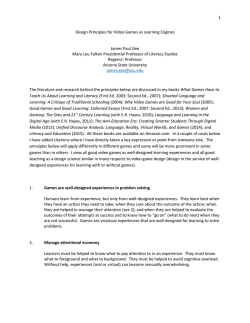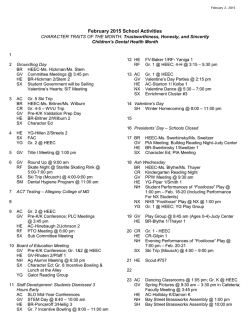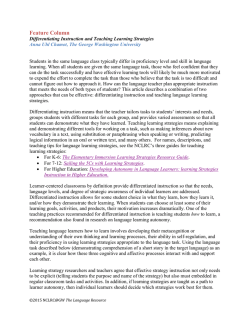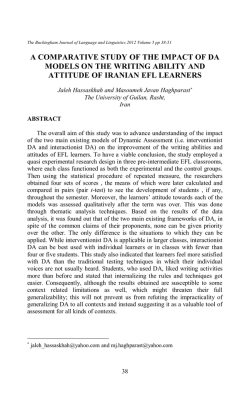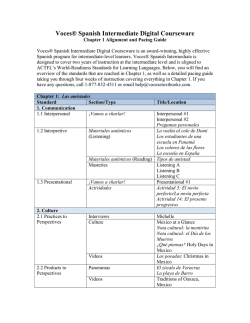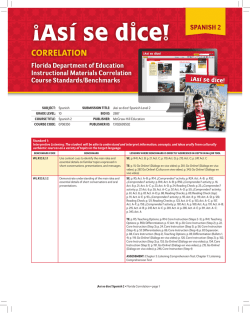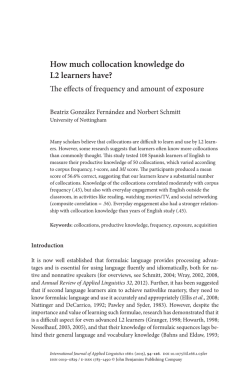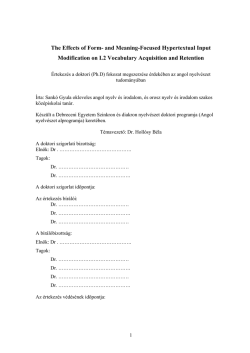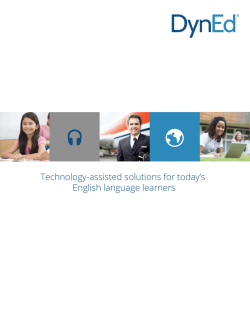
Differentiation Does, in Fact, Work
Published Online: January 27, 2015 Published in Print: January 28, 2015, as To the Contrary: Differentiation Does Work COMMENTARY Differentiation Does, in Fact, Work By Carol Ann Tomlinson Editor's note: The Commentary "Differentiation Doesn't Work," by James R. Delisle, provoked an avalanche of reader comments. Because of the extraordinary level of interest in the essay, Education Week is publishing this Commentary by one of differentiated instruction's foremost proponents. (See also Mr. Delisle's letter to the editor in response to the online comments and our primer on the issue.) It will not surprise educators who know my work to learn that my experiences and beliefs regarding academic diversity in classrooms differ from those of James R. Delisle, who recently made the case in an Education Week Commentary that differentiated instruction can't work in today's classrooms. Based on a conviction that conversation around differing vantage points is beneficial, I'd like to respond. I'll begin with the idea that teachers don't differentiate instruction. In fact, they do. I work with teachers regularly—in the United States and around the world—whose teaching consistently reflects the principles and practices of differentiation. It's how they do business. They don't, as Mr. Delisle writes, "beat themselves up for not doing it as well as they are supposed to be doing it," but they do understand that the pursuit of expertise in teaching is a careerlong endeavor. They aren't sprinters expecting quick success, so much as marathoners in the race for the long haul. Then there's the assertion that the only people who think differentiation is doable are those who have never tried to implement it. Speaking first for myself, I taught for 20 years in differentiated middle school classrooms, greatly enriched by working with a group of colleagues who did the same. Like many other teachers, then and now, we invented instructional approaches we hoped would benefit our diverse learners, keeping those practices that worked and jettisoning or modifying those that didn't. In my second life at the University of Virginia, I continue to differentiate in my classes. I also work often with school-based academic coaches and principals who share with colleagues the pract ices of differentiation they used successfully in their own classrooms. And there are many specialists —in special education, English-language learning, reading, gifted education—who continue to differentiate in particular settings, even as they share what they know while working alongside teachers in general education classrooms. Mr. Delisle's fundamental argument, however, doesn't seem to be so much that differentiation can't work under any circumstances, but rather that perhaps it could if we'd just group students by ability. While I know of no aspect of education on which all studies are in total agreement, this one comes close. For many reasons, students in lower-track classes don't achieve as well as they do in heterogeneous settings. Those classes tend to be taught by newer or less engaged teachers. The quality of curriculum and instruction is less robust than in most heterogeneous settings. The intellectual climate in tracked classes is further damped by students who know they are siloed because adults consider them to be less able than many of their peers—and they respond accordingly. Common sense and experience tell the story, as well. As the wise Bart Simpson told his teacher in one episode of "The Simpsons": "You think I'm not smart so you're gonna put me in a remedial class and slow down what I do. At the same time, the other kids will keep moving ahead, and you think someday I'll catch up?" Follow a remedial class throughout several school days, and it becomes very difficult to assert that students in all tracks have any degree of equitable access to excellent educational opportunity. One outcome of tracking that should be of particular concern in the current school year —the first in which "minority" students became the majority in U.S. schools—is the reality that low-track classes continue to be disproportionately composed of students of color and/or low-income students, while high-track classes remain disproportionately white and/or Asian and middle class. Educator Martin Haberman spoke of low-track classes as supporting a "pedagogy of poverty," a label he used to reflect two realities. First, most students in the low-track classes are from low-income backgrounds. Second, the quality of learning in those classes seems a guarantee that the students in them will remain poor. "I absolutely understand that differentiating instruction well is not easy. But then, I've never felt that teaching should be easy." Later, Helene Hodges, a former official of the education association ASCD, wrote about "a pedagogy of plenty," describing the nature of rich learning experiences in high-track classes, where more privileged students are the norm. Detailing the kind of intellectually rich environment typical of those classes, she concluded that they were not only heavily populated by students whose lives were marked by "plenty," but that continual engagement with the kind of learning opportunities in those classes predicted a continuing life of plenty for students in them. Recent work in neuroscience and psychology reveals two findings that should be central in educational planning. First, virtually all brains are malleable. When we teach as though students are smart, they become smarter. Second, a related but separate body of research indicates that teachers who believe firmly in the untapped capacity of each learner, and thus set out to demonstrate to stude nts that by working hard and working smart they can achieve impressive goals, get far better results than teachers who believe some students are smart, others are not, and little can be done to change that. It's difficult to grow brains and help students develop growth mindsets in remedial contexts. That undermines a chief point of Mr. Delisle's argument that bright learners can't fare well in heterogeneous classrooms. Studies have shown, after all, that advanced learners achieve more in homogeneous settings. I am a firm believer that schools owe every student what the noted researcher John Hattie calls "plus-one learning" in his book Visible Learning for Teachers. With plus-one learning, teachers are obliged to ensure that each learner—including those who are most advanced—moves forward consistently from his or her starting point. I have no more patience with classes where advanced learners stagnate than I do with classes that shortchange kids who struggle with school. Here are a couple of points worth considering, however. The studies most cited in terms of benefits of homogeneous instruction for bright learners examined two conditions: heterogeneous classrooms in which little or nothing was done to provide plus -one learning for advanced learners, and homogeneous classrooms in which teachers regularly planned for plus-one learning. In the two decades since those studies, I've observed and studied schools in which the entire faculty focused on providing a third condition: differentiation in mixed-ability classrooms where regular planning for a full spectrum of learners—including advanced learners—was a given. Teachers in those schools typically "teach up," planning first for advanced learners, then scaffolding instruction to enable less advanced students to access those rich learning experiences. Further, they extend the initial learning opportunities when they are not sufficiently challenging for highly advanced learners. In those schools, achievement for the full spectrum of learners —including advanced learners—rose markedly when compared to peer schools where this approach was not pervasive. For the record, I've never felt differentiation was a panacea. I have never advocated what I'd call "Noah's Ark" classrooms assigned two of every kind of learner in the school. I absolutely understand that differentiating instruction well is not easy. But then, I've never felt that teaching should be easy. I work with a growth mindset about teachers, as about students. I believe that with intelligent, sustained support, most teachers can learn—step by step and over time—the attitudes and skills necessary to provide plus-one learning in the context of classrooms that are both academically rich and academically diverse. Carol Ann Tomlinson is the William Clay Parrish Jr. professor and chair of educational leadership, foundations, and policy at the University of Virginia's Curry School of Education, in Charlottesville. She is also the author of numerous books on differentiated instruction, including The Differentiated Classroom: Responding to the Needs of All Learners, 2nd Edition (ASCD, 2014) and Assessment and Student Success in a Differentiated Classroom (ASCD, 2013). She leads the Differentiated Instruction Cadre for ASCD Professional Learning Services.
© Copyright 2026
